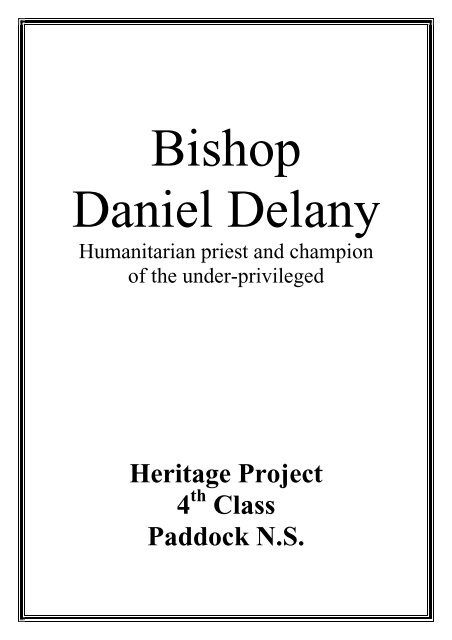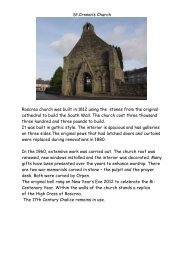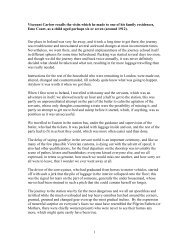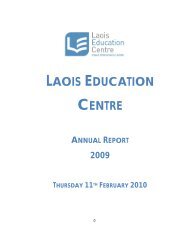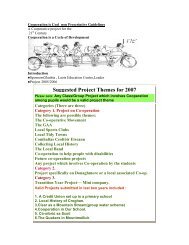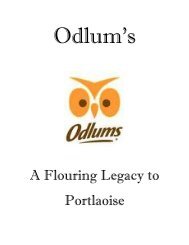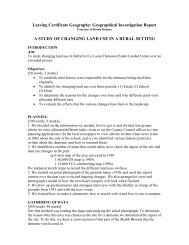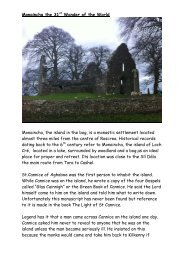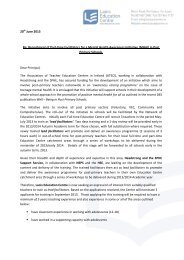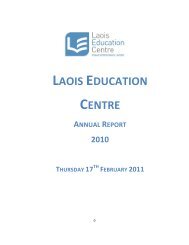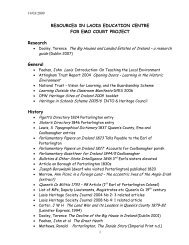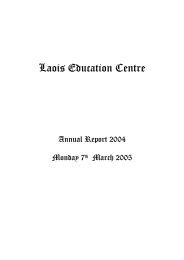heritage_project-_bi.. - Laois education Centre
heritage_project-_bi.. - Laois education Centre
heritage_project-_bi.. - Laois education Centre
Create successful ePaper yourself
Turn your PDF publications into a flip-book with our unique Google optimized e-Paper software.
BishopDaniel DelanyHumanitarian priest and championof the under-privilegedHeritage Project4 th ClassPaddock N.S.
Dr. Daniel Delany 1747-1814
Early LifeDaniel Delany was born in January 1747 in Paddock, inthe parish of Castletown, which is about 2 miles fromMountrath Co. <strong>Laois</strong>.His family were middleclass farmers. The ruinsof his home still standon the corner of thepresent day Bennettsfarm. Daniel’s parents’names were DanielDelany and ElizabethFitzpatrick. He was thefirst of two sons and was named after his father. Daniel’sfather died when Daniel junior was only a young childand Daniel’s younger brother also died in boyhood.Daniel attended the local school in Brisclagh, which wasprobably a hedge school at the time due to The PenalLaws. However when he was ten years old his mothersent him to live with his aunts in the nearby town ofMountrath. His aunts were known as the MissesFitzpatricks and they ran a-well-to-do business in thetown. He was considered a talented and attentive boy; hisaunt recognised this and gladly became responsible forhis <strong>education</strong>. The parish priest Fr. Denis Lawler becameDaniels guide and tutor. It is also said that a learnedProtestant gentleman who had been educated in Englandinstructed Daniel in Latin grammar. Daniel’s <strong>education</strong>had to be carried out in secret because of The PenalLaws. Catholic worship was also for<strong>bi</strong>dden at that timedue to these laws and mass was celebrated in the open air
and later in a hut built on the riverbank in Mountrath. Itwas in this hut that Daniel received his First HolyCommunion. Daniel also acted as a sacristan in the hut.His job was to arrange a simple altar for mass. When theriver flooded so did the hut and parishioners frequentlyhad to sweep out water before mass could be said.The homeplace of Bishop Daniel Delany after itsrenovations in 2009.Plaque on outside wall
Daniel Goes to FranceWhen Daniel reached the age of sixteen he decided not toreturn to his fathers farm in Paddock but instead tobecome a priest. He had to go to go to France to studysince seminaries were outlawed in Ireland. It is notknown how he was smuggled out of Ireland and little isknown about his clerical studies in France. We do knowhe was ordained about 1770 and in all spent aboutfourteen years in France. He taught theology at St. Omerand for the last six years there he occupied the Chair ofRhetoric at St. Omer, a position that showed how highlyhe was valued by his superiors.
Home from FranceIn about 1777 he returned to Ireland and Mountrath. Herehe carried out pastoral work but was very disillusionedby what he found. Poverty and hunger had driven manypeople into lawless bands. There were factions, fighting,drunkenness and religious duties were neglected.Mountrath was a much larger populated town then thanat present. He wished to return to France but the pleas ofhis mother kept him here.Curate of Tullow, Co. CarlowHe decided to stay and it wasn’t long before the <strong>bi</strong>shopheard of his pastoral a<strong>bi</strong>lities and brought him to Tullow,Co. Carlow as his curate. Daniel realised that lack of<strong>education</strong> was responsible for much of the evil around sohe started working with the children. He taught themhymns, prayers and catechism and he gathered somebetter-educated adults around him as assistants. He alsofounded the Confraternity of the Blessed Sacrament inTullow in 1785 and even though catholic worship wasstill opposed he held processions of the BlessedSacrament on Church festivals. He refused to let anyoneintimidate him.
Bishop Daniel DelanyIn 1783 at the age of thirty-six Fr. Delany wasconsecrated Bishop. He was coadjutor to Dr. O’ Keeffeuntil Dr. O’ Keeffe’s death in 1787. He then becameBishop of Kildare and Leighlin. Work had begun on St.Patrick’s College Carlow before Dr. O’ Keeffe’s deathand Bishop Delany continued the hard work to findfinances to carry on this work. The college survived andprospered thanks to Bishop Delany’s perseverance.St. Patrick’s College CarlowFrom the Dublin Penny Journal, Vol. 1, No. 14, September 29, 1832© LibraryIreland.com 2007
The Bishop Daniel Delany ChaliceIn 1789 Bishop Daniel Delany gifted this beautifulchalice to the parish of Mountrath.It bears the following inscription:“In honorem Sanctissimae Sacramenti Eucharistiae suisimpensis hunc calicem fieri curavit Reverendissimus DanielDelany, epus. Kilds. et Leighs. Donoque dedit parochiae deMountrath, 1789.”
Church BuildingDr. Delany also carried out a programme of churchbuilding and despite opposition from Orangemen inTullow and Mountrath he secured sites and churcheswere eventually built in both parishes due to his efforts.Bishop Delany had difficulty securing a site for thechurch in Mountrath as most of the land at that time wasowned by Protestants. The Coote family owned most ofthe land in Mountrath and refused to give a site for acatholic church. However he obtained a site for a churchfrom a generous Protestant lady named Mrs.Hawkesworth who owned a site by the river. Mrs.Hawkesworth by her own request was received into theCatholic Church on her deathbed. The original churchwas built on a poor foundation and was dismantled. Areplacement church was built later and stills stands theretoday as one of the finest churches in the diocese ofKildare and Leighlin.Church which now stands on site acquired by Bishop Daniel Delany
Brigidine SistersMeanwhile in Bishop Delany’s “Sunday Schools” theteachers and helpers were either getting married ormoving away. As he saw the success of people’s futuresthrough <strong>education</strong> and religion he decided to set upreligious houses to educate. On the 1 st of February 1807Bishop Delany gathered six deeply spiritual ladies fromamong his catechists in Tullow and the Brigidine Sisterswere formed. This community flourished and in 1809three Bridigine Sisters arrived in Mountrath to take upresidence in a row of houses near the church.Brigidine Convent, Mountrath
Patrician BrothersNow that Bishop Delany had provided for the <strong>education</strong>of girls he turned his attention to providing the same forboys. On February 2 nd 1808 the Patrician Brothers cameinto being in the old chapel in Tullow. On that morningBishop Delany said mass and received the first fourPatrician Brothers. They were, a schoolmaster who hadworked in Tullow for a number of years and three localtradesmen. On February 2 nd 1810 four Brothers were sentfrom Tullow to Mountrath where they established aboarding school. Because of growing numbers and ademand for more space the Patrician Brothers moved toBallyfin in 1930. It is perhaps ironic that the residencethey moved to in Ballyfin belonged to the Coote familywho had refused to give a site for the Catholic Church inMountrath.In 2009 The Patrician Brothers and The Bridigine Sistersamalgamated their two schools with St. Aengus PP in anew state of the art community school in Mountrath.
End of LifeFor the last six years of his life Bishop Delany helped theSisters and Brothers in the <strong>education</strong> of the young in thediocese. He helped them live the religious life, frequentlysaid mass for them and spent many hours in conversationwith them. By 1812 the Bishops health had failedconsiderably. Bishop Delany died in 1814 while masswas being offered at his bedside. He is buried in theparish church, Tullow Co. Carlow.
Delany MuseumUnderneath the Convent Chapel in Tullow Co. Carlowthere is a small museum dedicated to the life of BishopDaniel Delany, The Bridigine Sisters and The PatricianBrothers. It was opened to mark the <strong>bi</strong>centenary of theBridigine sisters. The museum is open for two Sundaysduring Heritage week, on Corpus Christi and St.Patrick’s Day and by appointment with a committeemember.
The Penal LawsThe Protestant Parliament did not keep the agreement ofthe Treaty of Limerick agreed by Sarsfield. In 1695 fouryears after the treaty harsh laws were passed againstCatholics called Penal Laws. The aims of the laws wereto keep the Irish Catholics poor and powerless. Theylasted 100 years. They had a huge effect on religion,<strong>education</strong>, property, and personal rights.ReligionOnly Catholic priest who were listed could stay inIreland. Mass had to be celebrated in secret as it wasfor<strong>bi</strong>dden to practice the Catholic religion.EducationCatholic children could not go to school or go abroad tobe educated. Catholic children were taught in homes,outhouses or in the open air. These were called HedgeSchools.PropertyCatholics could not buy or inherit land from Protestants.When a Catholic died his land was divided among hissons. But if a son turned protestant he would inherit all ofit.Personal RightsCatholics were not allowed own a weapon. They werenot allowed to vote. They couldn’t become a Member ofParliament either.
Some Sayings of Bishop Daniel Delany“We must not be like wheelbarrows,Useless unless we are pushed,But rather like a gold watch’Open-faced, pure gold, quietly busy,Full of good works”“Do ordinary things extra-ordinarily well”“What you are, those who come after you will be”“Lead one another to follow Christ more closely”“Love God and live together in peace and charity”


